
PREMIER League, OCTOBER 20 2024
Salah (29 pen)
Jones (51)
Jackson (45)
With victory in this closely fought game at Anfield, Liverpool extended their unbeaten run against Chelsea to 10 games. The Reds also maintained a one-point lead at the top of the table, as they registered a 10th win in their 11 games under Arne Slot’s management so far. While Chelsea were left without any points to show for their endeavour on this occasion, there were also positive signs for Enzo Maresca that his team is on the right track.
Despite the visitors’ strong opening spell, Mohamed Salah scored from the spot to put Liverpool ahead after 29 minutes, following Levi Colwill’s foul on an impressive Curtis Jones. Shortly before half-time, Liverpool and Jones thought they had been awarded another penalty – only for referee Jon Brooks to change his mind following an intervention by the video assistant referee.
Chelsea caught their opponents cold after the break, when Nicolas Jackson was played onside by Ibrahima Konaté and raced through to score. Jones – who also performed an effective marking job on Cole Palmer – was soon involved again, converting a Salah cross to quickly restore Liverpool’s lead. Despite chances for both teams to add to the scoring, that was how it stayed.
Below, our coaching experts have analysed and picked out the key tactical points from an intriguing October meeting at Anfield…
How the managers saw it
“In an ideal world we would’ve outplayed them completely,” said Arne Slot. “That's definitely not what we did. It was an equal game, in my opinion. There were phases in the game where we had to work really hard not to concede.”
“The [Chelsea] performance was very good,” said Enzo Maresca. “Coming to a stadium like this and this [Liverpool] team and thinking you will not concede chances or momentum is almost impossible, because of the environment, the team and for many reasons. For most parts of the game, we controlled it very well. We need to be proud of this, but at the same time a bit upset because we don’t like to lose games.”
 62264566173818811201243627254511201915
622645661738188112012436272545112019157/4
SHOTS / ON TARGET
11/2
44%
POSSESSION
56%
17
ATTACKS INTO AREA
31
1.54
EXPECTED GOALS (XG)
1.5
Chelsea’s back-three conversion
Chelsea’s 4-2-3-1 converted into a 3-4-3 in possession, with Malo Gusto inverting from left-back into an attacking position level with Palmer. This meant that, early in the game, Chelsea built around Liverpool’s 4-2-4 mid-block, finding their wingers to attack the host’s full-backs. With Liverpool’s front line narrowing, Salah and Cody Gakpo were caught in two minds whether to hold or jump, which often created wide 1v1s for Chelsea. At times Liverpool left-back Andy Robertson backed off, allowing Noni Madueke to progress (below). Jadon Sancho also had some joy against Trent Alexander-Arnold on the other side; despite getting into some promising situations, though, Chelsea failed to work regular attempts on target.

Maresca replaced Sancho with Pedro Neto at half-time, giving his team a more direct threat with the ball. Chelsea’s adapted midfield line started to connect more with each other, rather than always looking wide, as they had in the first half.
Moisés Caicedo and Roméo Lavia moved higher off the ball, looking to penetrate more between Liverpool’s lines. Although this gave Liverpool better spaces in which to counter-attack – especially in the centre – Chelsea’s best passage of play came as they combined and exploited centrally, for Jackson to penetrate beyond and calmly equalise (below).
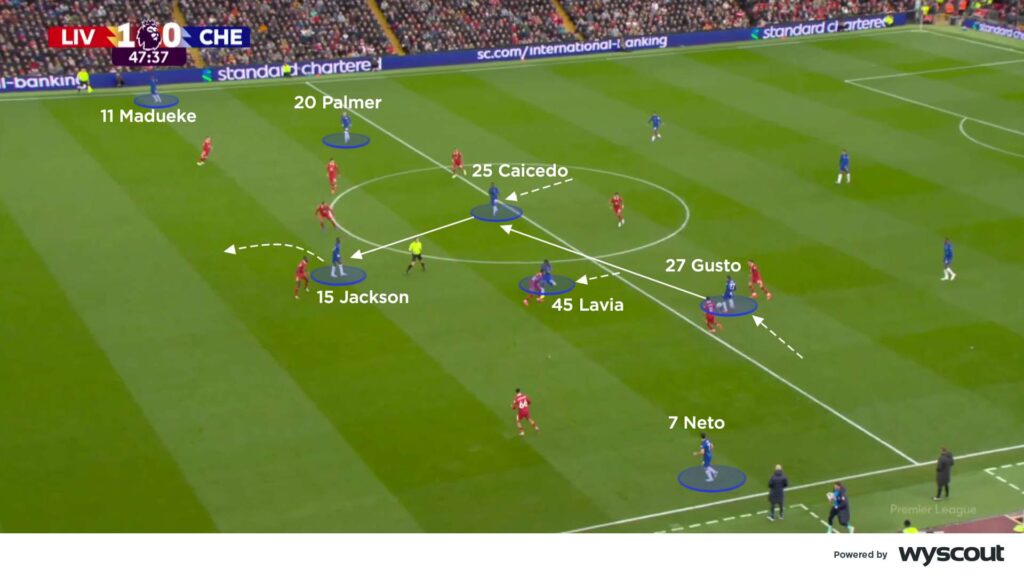
Supporting runs from central midfield helped Chelsea’s wider players to drive back inside, into key spaces in the inside channel. Ryan Gravenberch and Jones, however, did a good job of tracking these midfield runs, limiting the impact of Chelsea’s more advanced midfielders between the lines.
Another significant threat from Chelsea came whenever Neto or Madueke dribbled inside and beat their opposing full-back. But again, with Jones and Gravenberch tracking from midfield, Liverpool’s centre-backs were able to remain in shape. That meant they could overload Jackson (below); should Neto or Madueke carry the ball into a dangerous area, one of them could jump out without Liverpool being exposed.
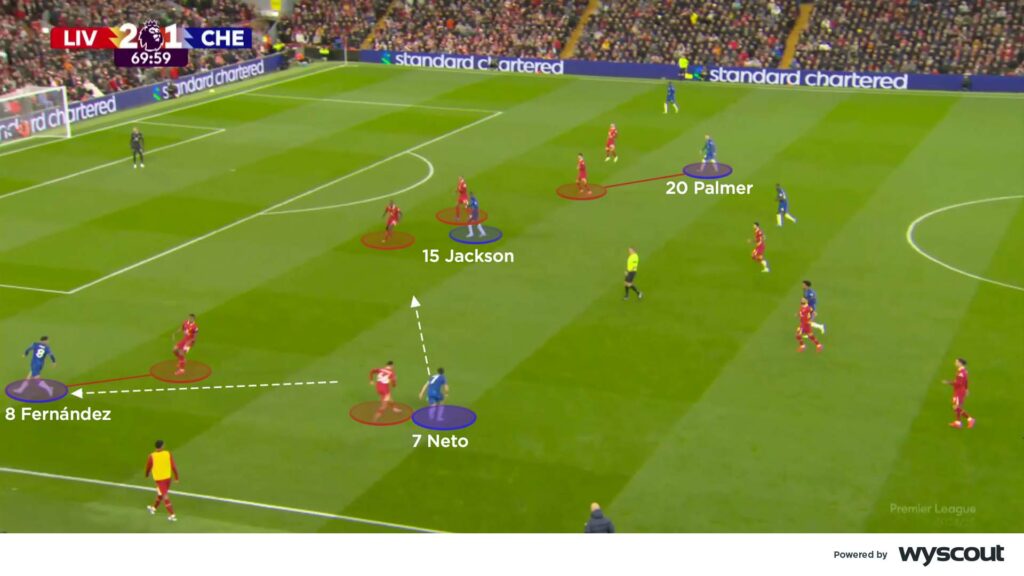
Liverpool playing over Chelsea’s press
Chelsea’s strong showing in the first half was also a result of their high press. Palmer and Jackson formed a front-line pair to jump on to Liverpool’s centre-backs, closely supported by Sancho and Madueke on the full-backs. Caicedo and Lavia took care of Liverpool’s two deeper midfielders, with their main trigger to jump coming when one of Chelsea’s centre-backs had joined in the press, picking up Liverpool’s highest central midfielder (Levi Colwill on Dominik Szoboszlai, below). Although Liverpool’s midfield was particularly fluid with their movements, Chelsea’s press worked well in limiting Liverpool’s build.
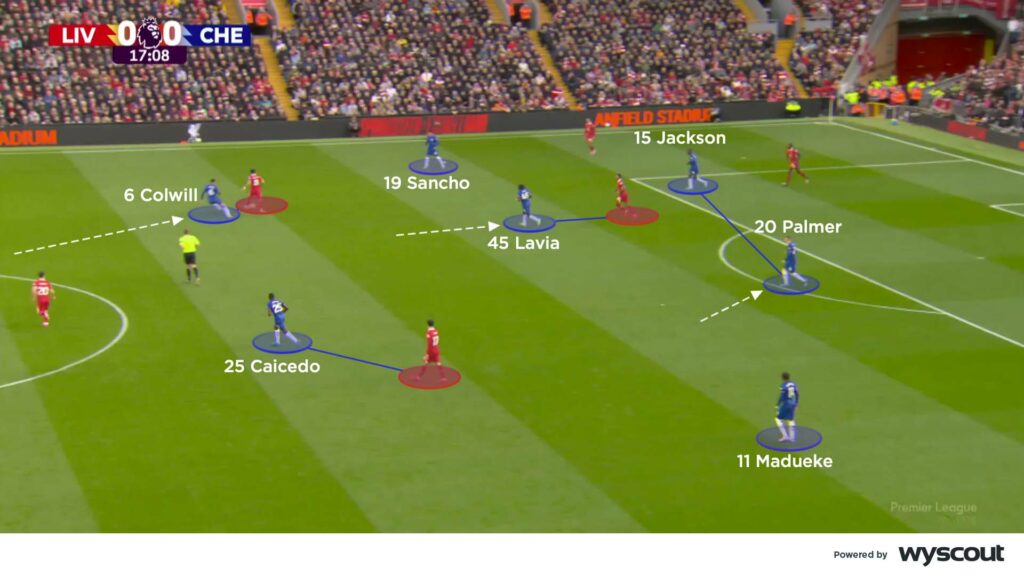
As a result, Liverpool started to go long into their front line, targeting Diogo Jota, before he was withdrawn after half an hour through injury. Although the physical Darwin Núñez replaced Jota – and his marker Tosin was on an early yellow card – Liverpool instead targeted Salah against Gusto, resulting in a competitive battle between the two. With Gakpo stretching wide left, and Jones making runs from midfield, whenever Salah secured the first contact, Liverpool often had a 4v4 against Chelsea’s back line (below). The visitors’ inability to deal with some of these forward runs duly resulted in Liverpool being awarded a penalty.
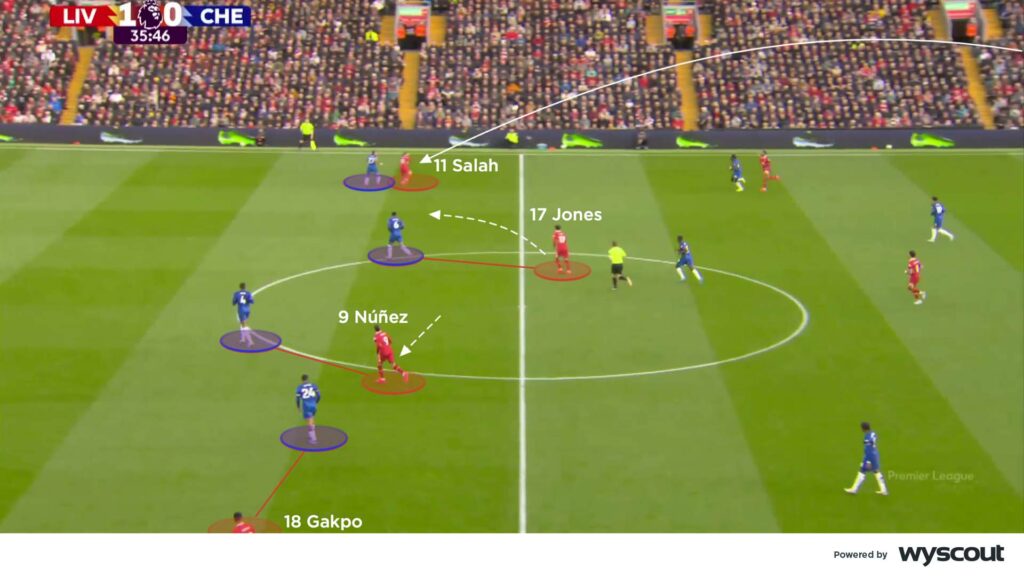
Jones’ box-to-box running
In the second half Liverpool’s long balls focused more on the second contact and midfield regains, as opposed to their front-line pinning and securing higher. Fluid movements from Liverpool’s central-midfield trio supported this. Jones and Szoboszlai’s movement more often than not helped Gakpo and Salah to attack spaces around, and just inside, Chelsea’s full-backs. And Jones’ box-to-box runs were excellent throughout the second half, not least when he pounced on Salah’s inswinging cross to restore Liverpool’s lead (below).
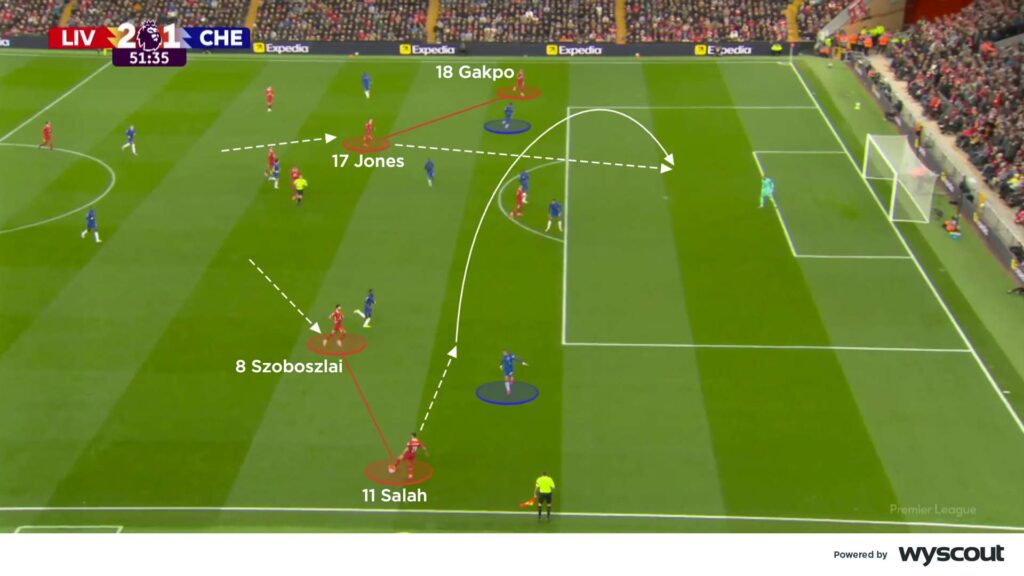
Liverpool’s midfield fluidity continued, with alternating players making runs around Salah’s dribbles on the right, dragging Chelsea over and freeing Gakpo on the left side. Jones’ penetrative runs became decoys, dragging Chelsea players narrow and deep to further free the opposite side (below). Although Liverpool didn’t add to their two goals, their attacking play was much more purposeful and penetrative in the second half, with lots of forward runs dragging Chelsea’s back line deeper.
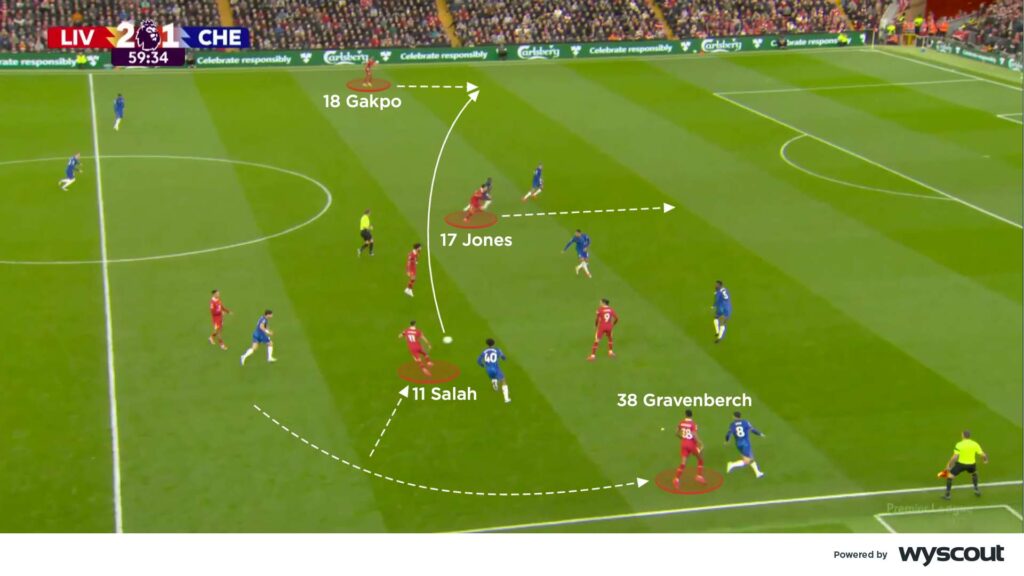
All in all, it proved to be a fascinating tactical battle between two highly rated head coaches who are still relatively new to their clubs. Regardless of the result, both teams were left with signs of encouragement from this game. And when the return fixture at Stamford Bridge takes place next May, Slot and Maresca will have had many more months to mould their respective teams in their image.
To learn more from professional coaches at Coaches’ Voice, visit CV Academy



